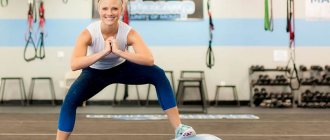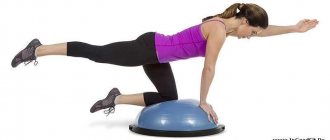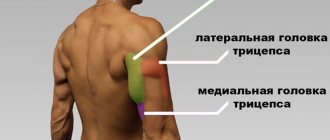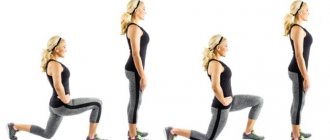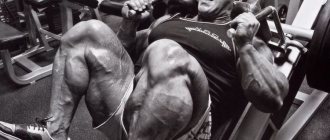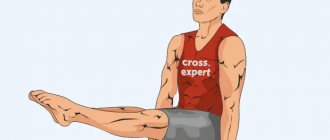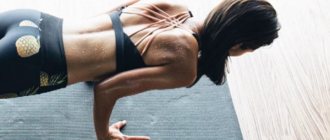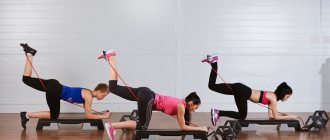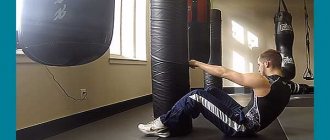In 1999, physiologist David Weck created the Bosu balancing platform, which quickly burst into the world of fitness and became a worthy alternative to fitball. The name of the simulator was borrowed from the expression “both side up”, which literally translates as “both sides up”. During exercises, two parts of the sports equipment are used: a hard flat part and an elastic domed part. Depending on which side of the platform you prefer, you can make your workouts more complex and thereby increase their effectiveness significantly.
What is bosu training?
The standard size of a bosu is 30 centimeters in height and 65 centimeters in diameter. You can place the hemisphere on the floor either with the dome up or down. In the first option, the athlete performs aerobic and strength exercises. And, turning the simulator upside down with the platform, it begins to develop balance and coordination. Such versatility is the main secret of the popularity of hemispheres around the world.
The abbreviation BOSU comes from the English expression “both sides up”, which means “using both sides”.
Who and when invented this type of training?
A new type of simulator that develops coordination was developed in 1999 by the American David Weck. The idea came to him during a Tai Chi lesson. David thought that Wushu fighters have excellent balance while standing on one leg and at the same time performing complex, energetic movements with their arms.
It’s just that it takes them years to master this skill. “What if we create a simulator that will help significantly speed up the process?” – it was with these thoughts that Wek repeatedly walked through sporting goods stores. The fitballs were good, but too unstable and prone to injury. But the hemisphere managed to combine both efficiency and safety.
Bosu has taken the fitness world by storm. Already in 2000, hemispheres appeared in most gyms in the world. Today, along with bike paths and orbit tracks, bosu is also competing for the title of the most popular home exercise machine.
Top manufacturers of Bosu exercise machines
- BOSU is an American brand that appeared in 2000, patented and was the first to begin producing hemispheres. The brand is very popular in the world, and in Russia their products can be found in more than a thousand fitness clubs. Starting cost from 16,500 rubles.
- IFITFUN - a Taiwanese brand that strives for the quality of Bosu originals, produces hemispheres with anti-slip platforms, making training safer. The brand has also added expanders to its products to work all the muscles of the body. The cost of goods varies from 7,500 to 14,000 rubles.
- Tunturi, a budget Chinese brand registered in the Netherlands, produces exercise equipment for home use, for example, Balance Trainer (14TUSFU152). The hemisphere is designed with two handles to improve the load. The company also took care of novice users by including a diagram with exercises in the set. Approximate cost is about 7,000 rubles.
Benefits of bosu training
The main benefit of bosu training is the ability to engage the stabilizer muscles and small intervertebral muscles. Usually during classes we use only large muscles. And only on an unstable surface the whole body is involved in the work.
Benefits of Bosu:
- Versatility.
Both men and women, beginners and experienced athletes can use the hemisphere in their exercises. Trainers of completely opposite types of fitness include barefoot exercises in their programs. And at the same time, everyone is invariably satisfied with the achieved result.
- Efficiency.
If the usual push-ups, planks, lunges have become too easy, you can start doing them on a hemisphere. This will burn many more calories and make the activity much more challenging.
- Strengthening the muscular frame.
Regardless of what exercises you perform on the machine, your core muscles are actively working all the time. The back is strengthened, beautiful posture is formed, and the abs quickly appear. Moreover, muscle imbalance is completely excluded, as sometimes happens if you get carried away with working out the deep abdominal muscles.
- Development of the vestibular apparatus.
Over the years, it has become a problem for many people not only to ride on a children's carousel, but even just to watch its work. Dizziness and nausea in transport are clear symptoms that the system has failed. And what is especially unpleasant: humanity has not yet invented drugs that can put the vestibular apparatus in order. The only way to get rid of unpleasant sensations is training. And bosu is one of the most effective exercise machines in this case.
- Ease of use.
To train barefoot, you don’t need to invent or memorize any special exercises. You can even do morning exercises familiar from childhood, but relying on a hemisphere. And the effectiveness of the training will increase significantly.
Bosu is often compared to a fitball, and always not in favor of the latter. Firstly, the risk of injury on the hemisphere is much lower. Secondly, you can train barefoot not only lying or sitting, but also standing. This gives more room for the fitness instructor’s imagination when developing the program.
Balancing sphere and its advantages
As we said in the introduction, if you're planning on incorporating balance training into your fitness plan, you should definitely consider purchasing a balance sphere. Essentially, it is a hemisphere with a flat platform
, which has the added advantage of being more usable. It's up to you to decide which half you prefer during your workout and how to rotate the mat.
Quality balance spheres also include 2 removable resistance bands with foam handles to try different exercise variations . When practicing with it, the so-called deep stabilization system , which is involved in stabilizing the body. These include the pelvic floor , back muscles , and the muscles of the spine and neck.
Exercises with a balance beam have several main benefits:
- helps prevent injury
- helps in rehabilitation
- improves posture
- reduces back pain
- diversify your workouts [7]
Who is bosu training suitable for?
You can use the balancing hemisphere in almost all fitness programs:
- calm:
yoga, Pilates, stretching;
- dynamic:
cardio, strength, functional.
Professional athletes also include exercises on the hemisphere in their programs: skiers, snowboarders, gymnasts, tennis players. Bosu is used by rehabilitation therapists in rehabilitation therapy for gentle stretching.
Even people who are not too fond of sports like Bos. Thus, office workers enjoy doing stretching exercises on a hemisphere in the evening. And on weekends they train to maintain balance. And what’s interesting is that even such a minimal load noticeably strengthens the abs and makes your posture straighter.
TOP 15 exercises on the bosu hemisphere
The optimal duration of a lesson on a hemisphere is 50-60 minutes. The training begins with simple basic exercises: alternately entering the platform with each foot, maintaining balance while standing barefoot. Gradually, the combinations become more difficult, and the training becomes more interesting.
We have collected the most effective bosu exercises that will pump up your entire body.
Exercise 1. Finding balance
Turn the bosu upside down so it's a hemisphere. Carefully enter the platform. And try to find balance. If the simulator is moderately inflated, this is not difficult to do. Shift your body weight from one leg to the other, getting used to the unstable position. Your task is to get to know the simulator.
Exercise 2. Warm up in a squat
The starting position of the simulator is the same. The feet are parallel on both sides of the platform. Squat down, moving your pelvis back, as if you were trying to sit on a chair. Find your balance. And start rolling, helping yourself with your hands.
Exercise 3. Squats on an inverted hemisphere
Without changing the starting position, actively and quickly begin squats. To warm up, it is enough to perform the movement 10-15 times, not forgetting to exhale as you rise. Experienced athletes can go even further and complete the set with several jumps, during which the feet barely leave the base of the Bosu.
Exercise 4. Jumping onto an inverted hemisphere
At the end of the warm-up, try to carefully jump onto the hemisphere and at the same time maintain balance. Don't straighten your legs, don't rush. Jump to the floor. And repeat the exercise 5-10 times.
Exercise 5. Plank with platform swing
After an active warm-up, we move on to the plank. The sphere is still installed base up. Lean against its edges with outstretched arms. Get into a plank position and begin to vigorously swing the platform from side to side. This movement uses all the back muscles.
Exercise 6. Rolling push-ups
The starting position is the same as in the previous exercise. Just now add push-ups. At the lowest point, exhale and roll four times from hand to hand. This exercise uses not only the abs and biceps, but also small intervertebral muscles.
Exercise 7. Climber
Starting position: rest on your toes and palms, which still stand on your inverted barefoot. The stomach is pulled in, the back is straight. As you exhale, pull your knee toward your chest, and as you inhale, return to the starting position. Repeat with the other leg. Perform at a fast pace for 1-2 minutes. The exercise is very popular among American fitness trainers, who believe that the “Mountaineer” works the abdominal muscles much more effectively than crunches and glute bridges.
Exercise 8. Lying emphasis, step forward
The starting position is the same as in the previous exercise. But now alternately take a wide step with one or the other foot. Place your foot to the side of the machine. The exercise provides a load to the abdominal muscles and works the inner thighs.
Exercise 9. Squats on one leg
The simulator is installed with the base up. Step on it with one foot, catch your balance. Then slowly and smoothly pull your knee up to your chest and then move your leg back. Repeat 5-10 times for each leg. The exercise effectively works the abs, outer and front thighs.
Exercise 10. Stepping to the side
Place the bosu with the sphere facing up. Spread your legs as wide as possible. Place one foot on the machine, the other firmly on the floor. Push off the floor sharply, jump over your barefoot so that your other leg is now on the hemisphere. Jump energetically and high, accompanying each jump with an exhalation.
Exercise 11. Step-up across the platform + 180 turn
A more complex variation of the previous exercise. The stretcher qualitatively pumps the adductor muscles of the thighs, quadriceps and gluteus maximus muscles. And it is one of the most effective exercises for the legs and buttocks.
Exercise 12. Squat with barefoot jumping
Place your feet on either side of the sphere. Squat down, touching your palms to the middle of the machine. Inhale and jump onto your barefoot with both feet. Jump back to the starting position. Repeat 5-10 times. The exercise pumps up the inner and outer thighs, strengthens the legs, and develops endurance.
Exercise 13. Hard pumping of the press
Sit on top of your barefoot so that you can fully straighten your legs without them touching the floor. Move your body back, fix the position in a reclining position. And start performing V-shaped crunches at a fast pace. The instability of the position forces all the core muscles to engage in work, and the abs will begin to burn after 10-15 repetitions.
Exercise 14. Pumping the abs with emphasis on one leg
We engage the oblique abdominal muscles. Sit on the barefoot. Bend one leg at the knee and place it on the floor. Pull the second one up. Lean back slightly. And begin performing V-shaped twists, trying to reach the toe of your outstretched leg with both hands. Repeat 10-15 times on each leg.
Exercise 15. Lifting the pelvis while lying on your back
Lie on your back, place both feet on your bare feet and begin, as you exhale, to lift your pelvis up, focusing on your feet. Repeat 10-15 times. And then the same amount, but lingering at the top point for 3-4 seconds.
Thanks to the following YouTube channels for the GIF: Sapinsky Training, Сoach Club - training for fitness trainers, Karen O'Connell.
Warm-up before Bosu Fitness
1. Tilt the neck back and forth and in different directions. In each direction, 10 repetitions 2. Rotate the neck clockwise and counterclockwise - 10 completed movements in different directions 3. Rotate the shoulders in pairs in one direction and the other - 10 rotations 4. Rotate the arms forward and backward - 10 repetitions 5 Rotation of the wrists in one direction and the other - also ten repetitions 6. Circular movement of the stomach forward and backward 7. Lateral lunges with legs - 10 times to the right and 10 to the left 8. Running in place - 2 minutes 9. Jumping in place with raising arms and spreading legs while jumping - 10 times 10. Rotating the legs around the toes of each leg 10 times 11. Marching on the Bosu ball - 25 times 12. Additional light stretching
You can also use this set of exercises to warm up before training.
After all this, it's time to start the main part.
Cons and contraindications
Despite all the advantages of the balancing platform, it also has disadvantages:
- Traumaticity.
Most often, those who exercise on the hemisphere suffer from ankle ligaments. Therefore, it is very important to monitor compliance with the technique. And even better - at least for the first time, study only under the guidance of an instructor.
- Complexity.
Even young and completely healthy people find it difficult to use the platform at first. If problems with coordination of movements already exist, mastering the simulator may take many months. Therefore, before you buy a hemisphere for home, it is better to go to group training at the nearest club to evaluate your own capabilities.
- Inability to use weights.
The first reason is that it is unsafe, because falls from bosu happen even among experienced athletes. The second reason is the weight limit. This indicator is individual for each model, but on average a hemisphere can withstand about 150 kilograms. This means that serious strength training on bosu is impossible.
Training on a balancing platform is strictly contraindicated for people who are overweight and have problems with the musculoskeletal system. It is not recommended to practice bosu for those who often experience dizziness and suffer from low blood pressure.
Tips for Beginners
- Exercise in shoes with flat rubber soles
– sneakers or sneakers. When you feel more confident on the hemisphere, you can perform the exercises barefoot.
- Before starting the complex, be sure to warm up.
When you lose balance, “cold” muscles are easier to injure.
- For the first training, do not try to inflate your boss as much as possible.
: The less elastic the hemisphere, the easier it will be to master a new type of fitness.
- Take care of your inventory.
Some instructors suggest adding variety to your workout by flipping the bosu. But you must understand: if you regularly stand on a flat base, the exercise machine will quickly become unusable.
- Pick up dumbbells
only when you master the hemisphere well and learn to stand on it in any position.
- Place your feet closer to each other
when standing on the dome part. Bend your knees halfway. This is the easiest way to maintain balance.
Most importantly: don't expect instant results! Bosu training is difficult and unusual for a beginner. And the fact that in the first weeks you will constantly lose your balance is quite normal. Be patient and within a month you will get used to the new simulator.
Side plank with forearm support
Lie on your left side, place your left forearm on the apparatus, placing it perpendicular to the body. Place your right hand on top of it (to make the exercise more difficult, you can place your right hand on your thigh). The right leg is clearly on top of the left, do not tilt the body back. Using the outside of your left foot and left forearm, lift your pelvis and move into a side plank position, keeping your body in a line from the top of your head to your feet. Lock yourself in this position. Then return to the starting position. Complete the required number of repetitions and switch sides.
How to choose bosu platform?
The cost of Bosu simulators starts at 5,000 rubles. But, of course, we are not talking about products from professional brands. However, such a simulator will help an amateur to stay in good shape. The main thing is to pay attention to several points when purchasing:
- a good hemisphere is a non-slip hemisphere;
- the product should not allow air to pass through: this is easy to check - just sit on the platform, a low-quality product will begin to descend like an air mattress;
- choose models that already come with a pump;
- check the weight limit: some bosu can only support up to 100 kg.
With experience comes the need for professional simulators. The leader in bosu production remains the American brand of the same name, but the starting price for such spheres is 16,500 rubles. The brands Ifitfun from Taiwan and Tunturi from China have also proven themselves well. Their products are much cheaper: from 7,500 rubles.
Reviews
Stanislav5
The thing looks simple, but is multifunctional (it will help improve (restore) posture, correct figure imperfections and increase endurance). This miracle thing is good for aerobics. The exercises are the same if you have ever attended group fitness classes. Another advantage of the Bosu is that it can be turned over and used on a flat surface. Of course, maintaining a balance like this is even more difficult, but it is also useful. Personally, I started training twice a week. Sometimes there are three, but rarely. Barefoot exercises, although gentle in terms of assistance and stress on your joints and muscles, are energy-consuming in terms of calorie loss. If you love winter sports, then Bosu will help you remember your skills and, in addition, help you strengthen your endurance. And all this while maintaining balance. After all, balance is very important in figure skating, skiing and snowboarding, which is very fashionable today.
IrinaFedash
The Bosu platform is a hemisphere (very similar to a fitness ball, only it has a mat and a plastic base at the bottom). The hemisphere itself can be pumped more or less, depending on the level of training and the desired result; for the best result, it needs to be pumped up well, so that doing the exercise is difficult, because on Bosu, in order to maintain balance, you need to put in a lot of effort. You can also use the simulator in several variations: with the “ball” up or with the plastic base up! Probably many will ask what exercises can be done on it? - all the same ones that you perform in regular fitness or aerobics, only performing ordinary steps or jumps will be much more difficult than on the floor, and so will the rest of the exercises! This platform further develops endurance and coordination of movements, but I don’t consider it an integral fitness tool, but it will definitely help you complicate your workout and make it fun!
